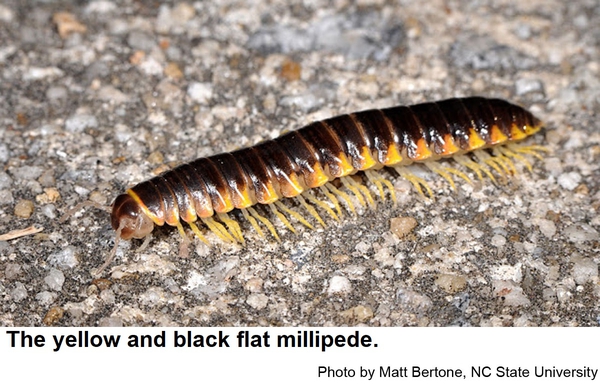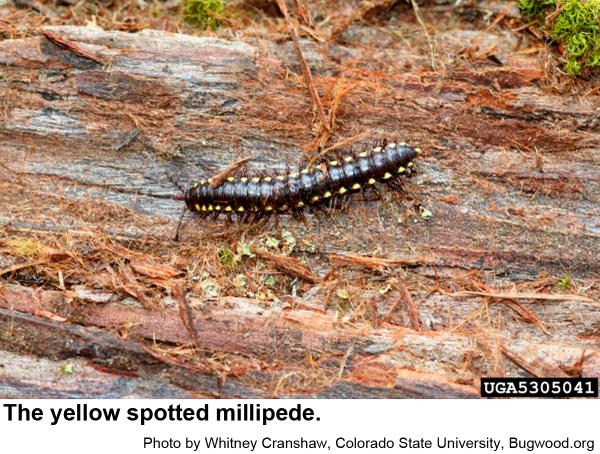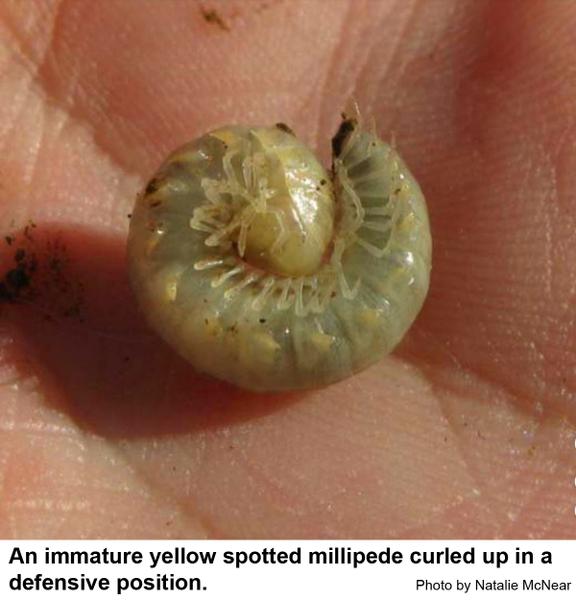Description and Biology
The yellow and black flat millipede, Apheloria tigana, could well be called the almond-scented millipede or the cyanide millipede because of the hydrogen cyanide that it secretes when molested. (At low concentrations, hydrogen cyanide smells like almond extract.) Although hydrogen cyanide is exceedingly toxic, the small amount each millipede produces is not hazardous to human health. Yellow and black flat millipedes are large (up to 2 inches long), flattened, black arthropods with yellow spots along the sides. They have 31 pairs of legs (females) or 30 pairs of legs (males). The millipede also protects itself by curling into a ball, resembling a snail. Females lay several hundred eggs in a moist, protected location, commonly under a log. Eggs are laid where there is a ready food supply for the newly hatched tiny young. Eggs hatch after three or more weeks of incubation. Immature millipedes are pale and have fewer segments and legs than mature millipedes. As they molt and grow, immature millipedes become darker, the spots get brighter, and they add body segments with each molt. Yellow and black flat millipedes live 2 to 3 years. A very similar millipede, the yellow spotted millipede, occurs in the Pacific Northwest.
Food
Mature yellow and black flat millipedes feed on a variety of dead leaves and decayed wood including both conifers and several deciduous species. Immature millipedes feed on humus. The litter that this millipede consumes is digested and excreted as fecal pellets.
Residential Recommendations
Yellow and black flat millipedes never seem to be abundant in North Carolina. Because they contribute to the breakdown of leaf litter into humus, ecologically yellow and black flat millipedes may be considered neutral to beneficial. No pesticide application seems to be warranted.
Other Resources
- Yellow-spotted millipede, Harpaphe haydeniana. Anonymous. 2016. Klamath Network Featured Creature. National Park Service, U.S. Department of the Interior, Natural Resource Stewardship & Science Klamath Network.
- Checklist of the millipeds of North and Middle America. Hoffman, R. 1999. Virginia Museum of Natural History Special Publications 8, 1–553.
- Extension Plant Pathology Publications and Factsheets
- Horticultural Science Publications
- North Carolina Agricultural Chemicals Manual
For assistance with a specific problem, contact your local N.C. Cooperative Extension Center
Publication date: July 2, 2019
Revised: May 19, 2021
N.C. Cooperative Extension prohibits discrimination and harassment regardless of age, color, disability, family and marital status, gender identity, national origin, political beliefs, race, religion, sex (including pregnancy), sexual orientation and veteran status.




